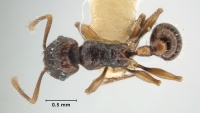Tetramorium andrynicum
| Tetramorium andrynicum | |
|---|---|

| |
| Scientific classification | |
| Kingdom: | Animalia |
| Phylum: | Arthropoda |
| Class: | Insecta |
| Order: | Hymenoptera |
| Family: | Formicidae |
| Subfamily: | Myrmicinae |
| Tribe: | Crematogastrini |
| Genus: | Tetramorium |
| Species: | T. andrynicum |
| Binomial name | |
| Tetramorium andrynicum Bolton, 1977 | |
Nothing is known about the biology of Tetramorium andrynicum.
Identification
Bolton (1977) - The construction of the petiole in this species is remarkably similar to that of Tetramorium noratum of Malaysia and Borneo but whether this represents a true relationship or a convergence is not known. I suspect the latter as there are considerable differences in size and sculpture between the two. Amongst the Australian tetramoriines with II-segmented antennae this species is the least sculptured and has a very conspicuously impressed metanotal groove. These two features combined with the characteristic head-shape noted above should easily differentiate this species from all others in Australia.
Keys including this Species
Distribution
Latitudinal Distribution Pattern
Latitudinal Range: -17.43333° to -17.448355°.
| North Temperate |
North Subtropical |
Tropical | South Subtropical |
South Temperate |
- Source: AntMaps
Distribution based on Regional Taxon Lists
Australasian Region: Australia (type locality).
Distribution based on AntMaps
Distribution based on AntWeb specimens
Check data from AntWeb
Countries Occupied
| Number of countries occupied by this species based on AntWiki Regional Taxon Lists. In general, fewer countries occupied indicates a narrower range, while more countries indicates a more widespread species. |

|
Estimated Abundance
| Relative abundance based on number of AntMaps records per species (this species within the purple bar). Fewer records (to the left) indicates a less abundant/encountered species while more records (to the right) indicates more abundant/encountered species. |

|
Biology
Castes
Nomenclature
The following information is derived from Barry Bolton's Online Catalogue of the Ants of the World.
- andrynicum. Tetramorium andrynicum Bolton, 1977: 143, figs. 66, 67 (w.q.) AUSTRALIA.
Unless otherwise noted the text for the remainder of this section is reported from the publication that includes the original description.
Description
Worker
Holotype. TL 3.4, HL 0.78, HW 0.68, CI 87, SL 0.64, SI 94, PW 0.52, AL 0.92.
Mandibles finely and faintly longitudinally striate. Head in full-face view narrowing behind the eyes, the occipital margin strongly impressed medially (Fig. 66). Eyes small, maximum diameter c. 0.16, about 0.23 x HW. Anterior clypeal margin with a shallow median impression. Antennal scrobes feebly developed and shallow, not capable of accommodating the scape, the latter long. Alitrunk in profile with metanotal groove deeply impressed, the dorsum of the propodeum humped between the groove and the bases of the spines (Fig. 67). Propodeal spines long, narrow and acute; metapleural lobes low, triangular and acute. Petiole in profile with dorsum strongly convex (Fig. 67), in dorsal view longer than broad. Dorsum of head weakly sculptured; with median carina distinct and with a strong ruga on each side of the median carina about mid-way between it and the frontal carinae and running back to the level of the posterior margin of the eyes. Apart from this the dorsal head is smooth and shining with only a few feeble, disorganized, meandering and widely scattered rugulae posteriorly. Dorsal alitrunk more weakly sculptured than head, with only traces of feeble, widely spaced rugulae separated by wide smooth, shining areas. Petiole, post petiole and gaster completely smooth, unsculptured. Hairs numerous on all dorsal surfaces of head and body. Colour dark brown, the appendages yellowish brown.
Paratypes. As holotype, with dimensions TL 3.2-3.3, HL 0.74-0.76, HW 0.66, CI 87-89, SL 0.60-0.64, SI 91-97, PW 0.46-0.50, AL 0.88 (2 measured).
Type Material
Holotype worker, Australia: Queensland, Mt Bartle Frere, W. slope, 3000-5000 ft, xii.1957 (Darlingtons) (Museum of Comparative Zoology). Paratypes. 2 workers and 2 queens with the same data as holotype (MCZC; The Natural History Museum).
- Holotype, worker, west slope, Mt. Bartle Frere, Queensland, Australia, Museum of Comparative Zoology.
References
References based on Global Ant Biodiversity Informatics
- Bolton B. 1977. The ant tribe Tetramoriini (Hymenoptera: Formicidae). The genus Tetramorium Mayr in the Oriental and Indo-Australian regions, and in Australia. Bulletin of the British Museum (Natural History). Entomology 36:67-151.

